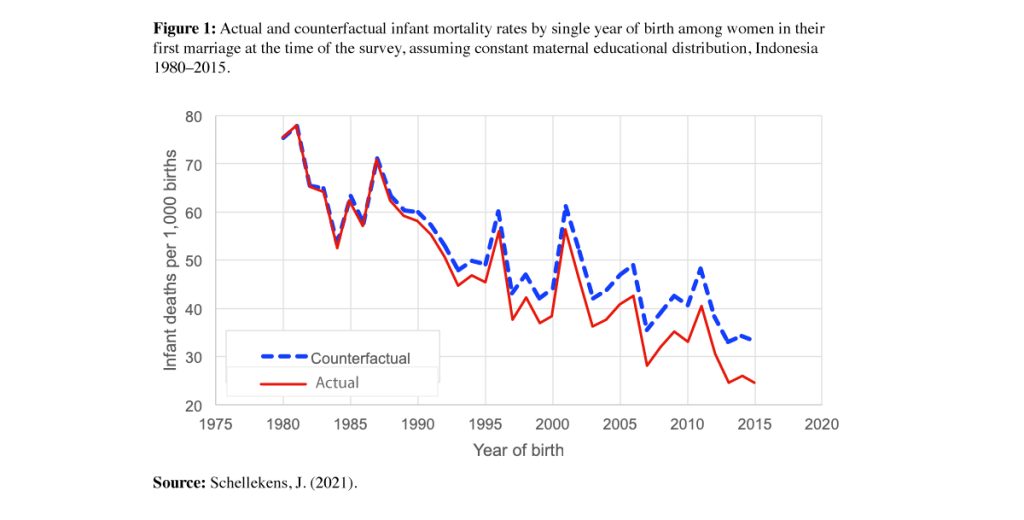Maternal education and infant mortality decline in Indonesia

Better maternal education has been credited with making a major contribution to infant mortality decline. However, previous studies have overestimated the contribution of better maternal education. Using individual-level data from Indonesia, Jona Schellekens shows that better maternal education explains only 15% of the infant mortality decline from 1980 to 2015.
Infant mortality has declined dramatically in less-developed countries. There are three major explanations for the decline: improved living standards, advances in medical and public health, and better maternal education.
Caldwell (1979) was the first to stress the importance of better maternal education as a means to lower infant mortality. He argued that maternal education is not merely a reflection of the standard of living and should be considered as a third explanation alongside rising living standards and advances in medical and public health. It is thought that better-educated mothers seek medical care more actively; are more aware of sanitary precautions, nutritional information, and health services; and are better able to recognize serious child health conditions. This effect on child health is also known as the cognitive effect of maternal education.
Caldwell’s hypothesis has received support from many studies whose results have been widely publicized. Part of the evidence linking maternal education to infant mortality decline is based on cross-sectional studies. In a cross-sectional study, the investigator measures participants’ outcomes ‒ such as infant mortality among more and less educated women who gave birth in the same year ‒ at the same moment in time. However, to test Caldwell’s hypothesis a longitudinal approach is needed to estimate the probability of infant death among women who gave birth in different years. In particular, this enables investigators to determine the extent to which infant mortality has declined over time because of a decline in the percentage of less-educated mothers.
Longitudinal studies often use national averages (e.g. Gakidou et al. 2010). However, correlations based on national averages tend to be higher than correlations based on individual-level data. I therefore performed a longitudinal analysis using individual-level data for Indonesia, which is especially interesting to study, because it is large (the fourth most populous country in the world) and because, among the ten most populous countries, it experienced the second greatest increase (after Russia) in education among women aged 25–34 years between 1970 and 2009 (Gakidou et al. 2010).
Using all available waves of the Demographic and Health Survey (DHS), and using counterfactuals, I estimated the cognitive effect of maternal education on infant mortality (Schellekens 2021).
A counterfactual analysis
Counterfactuals are “what-if”, thought experiments, alternatives to what actually happened; they imagine what would have happened if, contrary to fact, some condition had been changed. Economists pioneered the use of counterfactuals in the social sciences (McCloskey 1987), and demographers have now started to use them as well (e.g. Lutz et al. 2019).
What would have happened to infant mortality decline in Indonesia if maternal education had not improved after 1980? ure 1 provides the answer. It presents estimates of actual (red line) and counterfactual (blue line) infant mortality rates by single year of birth. Counterfactual values are estimated assuming no change in the distribution of maternal education after 1980. The figure shows that the decline in infant mortality would have been just slightly smaller if maternal education had not improved. In other words, better maternal education explains only about 15% of the infant mortality decline in Indonesia from 1980 to 2015.

The contribution of maternal education to infant mortality decline is estimated net of the contribution of other factors known to affect infant mortality, such as maternal age, number of previous births, length of the preceding birth interval, paternal education, urban residence, and average living standards. When trying to estimate the maternal cognitive effect, it is important to consider factors that may be associated with maternal education. For example, more educated women tend to be wealthier. As a result, if family wealth is not taken into account, the effect of maternal education may also reflect the effect of living standards in addition to a cognitive effect. The analysis used paternal education as a proxy for family wealth. To control for the rise in living standards, the analysis included variables indicating the year of birth.
Implications
If better maternal education made a relatively small contribution to infant mortality decline, at least in Indonesia, other factors must be responsible for most of the decline, such as improved living standards and advances in medical and public health. Combined, these factors explain 85% of the decline, although more research is needed to better assess the relative contribution of each one.
Even though better maternal education made only a small contribution to infant mortality decline, this does not imply that it is not important. Empirical studies have shown that better education can make a large contribution to the health of the mothers themselves (e.g. Schellekens 2020).
References
Caldwell, J.C. (1979). “Education as a factor of mortality decline: An examination of Nigerian data.” Population Studies 33: 395–413.
Gakidou, E., Cowling, K., Lozano, R., and Murray, C.J.L. (2010). “Increased educational attainment and its effect on child mortality in 175 countries between 1970 and 2009: A systematic analysis.” Lancet 376: 959–974.
Lutz, W., Crespo Cuaresma, J., and Gailey, N. (2019). “The demographic dividend is driven by education, not changes in age structure.” N-IUSSP.
McCloskey, D.N. (1987). “Counterfactuals.” Pp. 701–703 in The New Palgrave: A Dictionary of Economics, Vol 1, edited by J. Eatwell, M. Milgate, and P. Newman. London: Macmillan Press.
Schellekens, J. (2020). “Explaining disability trends in the United States, 1963-2015.” N-IUSSP.
Schellekens, J. (2021). “Maternal education and infant mortality decline: The evidence from Indonesia, 1980–2015.” Demographic Research 45: 807–824.